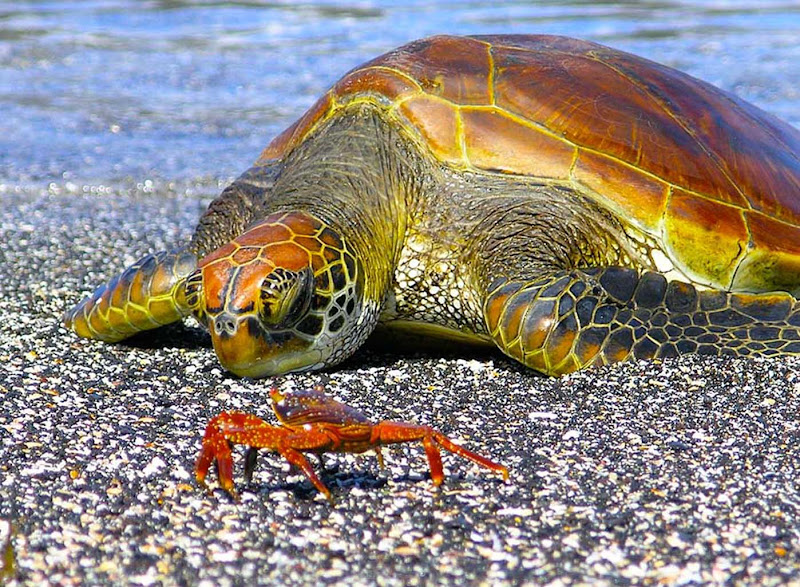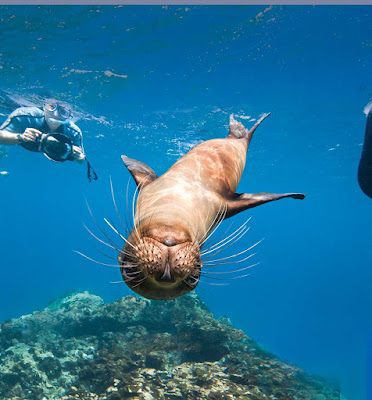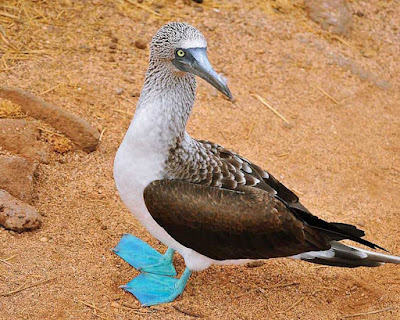Reality check
If you take an expedition cruise on a small expedition ship, don't expect the kinds of amenities and creature comforts you'd find on a larger ship, such as a choice of dining venues, onboard activities, Internet cafes, casinos or the like.

Christine Loomis / Special to CruiseableChristine Loomis: “I love this shot. Once the turtle starting swimming toward shore, all I had to do was lay on a rocky beach for a while and wait. The Galapagos are just zillions of photo ops waiting to happen.”
Options for visitors
Many hotels catering to tourists, both budget and high-end, have been established in recent years on the Galápagos’ inhabited islands. in fact, 35 percent of visitors now spend at least one night on land. Consider a post-cruise stay of a few days to explore the islands from a different point of view. Contact a Cruiseable travel professional for suggestions.
The biggest choice you’ll make, besides which vessel to cruise on, is how many days to spend exploring the islands. Much depends on your budget and the depth of your interest. Vessels typically visit two landing sites per day, with itineraries (which can be combined) focused on the north, central or south islands (described in order, north to south, below).
Each landing site features a unique environment and combination of wildlife species. While cruises as short as three nights are available, a 14-night itinerary is required for the greatest variety. There are two airports in the islands, one on the island of Baltra and one on San Cristóbal. You may fly into one and out from the other.

Courtesy of Lindblad ExpeditionsA wild flamingo spotted in the Galapagos on a Lindblad expedition.
- San Cristóbal Island: The airport is in the provincial capital, Puerto Baquerizo Moreno. Typically, arriving cruise passengers are shuttled first to the national park interpretation center, where exhibits introduce the history of the islands in the context of nature, humankind and conservation. Many first-day itineraries also include a visit to the Cerro Colorado breeding center for endangered giant tortoises.
- Genovesa (Tower) Island: This small island in the northeast part of the archipelago is known for huge colonies of frigate birds, boobies and petrels, and also has some great spots for snorkeling and kayaking.
- Santiago Island: This is the place to see (and perhaps swim with) fur seals, and to observe marine iguanas.
- Fernandina Island: There is only one visitor site at this westernmost, most volcanically active and most pristine of the islands. Ferocious-looking marine iguanas, brightly colored Sally Lightfoot crabs, the world’s northernmost species of penguins, flightless cormorants and sea lions are among the diverse wildlife to be observed.
- Isabela Island: This largest island in the Galapagos is home to more than 6,000 people, many of whom work in tourism. The main town, Villamil, is considered the islands’ prettiest. It has many hotels and restaurants and is popular for pre- and post-cruise stay-overs. Land tortoises, sea turtles, marine iguanas and many species of birds can be seen at the designated shore-excursion sites, and some itineraries also include a tortoise breeding center. Isabela, sometimes called Albemarle, is the only island in the Galapagos crossed by the equator.
- Santa Cruz Island: This is the main tourist hub in the islands. Puerto Ayora, with some 12,000 inhabitants, is the archipelago’s largest town. Its Charles Darwin Research Center is included on many cruise itineraries. Other highlights include excursions to giant tortoise habitat in the mountainous interior, nesting areas for green sea turtles, and feeding grounds for many species of shorebirds, including flamingos.
- Plazas Islands: Of the two tiny islands off the east shore of Santa Cruz, only South Plaza has a visitor landing site (North Plaza is reserved for research). Red-billed tropicbirds, swallow-tail gulls and an iguana that is a cross between marine and land species are among the highlights, along with a colony of more than 1,000 sea lions.
- Baltra (South Seymour) Island: This volcanic speck just north of Santa Cruz was once a U.S. airbase and today is home to an airport connecting the Galapagos with the Ecuadorian mainland. A large colony of sea lions, as well as lava gulls and colorful crabs, easily can be observed from the sandy shoreline.
- Santa Fe (South Plaza) Island: Sea lions, land iguanas, scuba diving and trails leading to vista points with expansive views are the main attractions at the landing sites here.

Courtesy of Lindblad ExpeditionsHave an amazing snorkeling adventure with playful sea critters.
- North Seymour Island: If you’ve been itching to get up close and personal with the prehistoric-looking marine iguanas for which the islands are so well known, this is the place. Blue-footed boobies and frigate birds are the other marquee species to be observed here.
- Bartolomé (Bartholomew) Island: This is perhaps the most visited and most photographed island in the chain, primarily due to iconic Pinnacle Rock and the presence of Galapagos penguins, the only wild penguin species on the equator. Great swimming, too.
- Santiago Island: Included on most itineraries, this uninhabited island is known for its colony of fur seals.
- Floreana Island: This island’s interesting human history includes a “post office” established by whalers in 1793. While the island has been greatly altered by human presence, shore excursions at two sites provide great snorkeling and opportunities to observe flamingos and sea turtles.
- Española (Hood) Island: The southernmost island in the chain is a classic shield volcano and home to a giant tortoise species rescued from the brink of extinction, as well as large populations of sea lions, lava lizards and blue-footed boobies. It is also the only breeding site in the world for the endangered waved albatross, whose nesting grounds are considered by many visitors to be the highlight of their Galápagos visit. The island has a beach for swimming and snorkeling.
Family-friendly trips to the Galapagos
If you plan to give your children the once-in-a-lifetime thrill of a visit to the Galápagos, you may want to choose a vessel offering special programming for them. Lindblad Expeditions, which teams with National Geographic for these kinds of expeditions, offers special kids-only programs, including photo workshops and hands-on science and conservation projects.
Before you go
Charles Darwin’s Voyage of the Beagle, an account of his momentous 1835 visit to the islands, is a very readable introduction to the observations behind his theory of natural selection, which rocked the Victorian world and continue to make waves in conservative religious circles.
Best bets for dining
The cruise lines provide meals as part of your itinerary. You'll also likely spend lunchtime on one or two days at restaurants in the towns, which serve local and international fare. In Puerto Aroya or other towns, don’t miss out on ceviche, lobster and other seafood specialties. Depending on the itinerary, you may also take your daytime meals on your cruise vessel. In the evening, swap tales over dinner with fellow ship passengers, some of whom may have gone on a different outing that day.
Best time to go
Cruises operate year-round. Weather is influenced by ocean currents, and what you’ll see in terms of wildlife activity varies according to the life cycles of individual species.
December to May is the warmer season, with daytime highs averaging in the high 70s to 80s. Afternoon showers are frequent, but the seas and wind are calmer. June to December is drier and cooler, with average daytime temperatures in the low 70s. During this season, the “garua” (fog) comes in, and seas are rougher. But hiking is more comfortable, and wildlife — particularly whales, whale sharks, dolphins and nesting albatross — are more active.
Wet season: The warm currents surrounding the islands December-April bringing calm seas, water temperatures in the 70s, daytime highs in the high 80s and sporadic rains. March is the hottest month and also the peak of the rainy season.
Dry season: Between May and November, the Humboldt and Peru currents arrive to plunge water temperatures into the 60s. Trade winds blow, a sea mist known as garúa sometimes sets in, and daytime temperatures are cooler, typically in the very comfortable lower 70s. Rain is infrequent.
High season: May, June and November to mid-January are the busiest months for tourism.
Fun (and not so fun) facts

Photo courtesy of Silversea CruisesFlat terrain allows guests a close view of the blue-footed booby. About half of all breeding pairs nest on the Galapagos.
- Charles Darwin arrived in the Galápagos aboard the HMS Beagle in September 1835, when he was 26 years old. He was not a scientist but a lapsed seminary student who came aboard the years-long surveying expedition as an amateur naturalist and social companion to the captain, Admiral Robert FitzRoy, also in his 20s. Darwin suffered terribly from sea-sickness and welcomed the opportunity during his five weeks in the islands to collect plants, rocks, birds and insects on solid land. He noticed that various species, finches and tortoises in particular, varied in appearance from island to island. His famous theory of natural selection, which holds that evolutionary change is derived through biological traits that become more or less common from generation to generation, was set out in his 1859 tome On the Origin of Species, and remains controversial in some quarters to this day.
- Ever since the first whalers arrived in the late 1700s and began harvesting tortoises and marine life, the islands’ delicate ecosystems have been increasingly threatened. Population pressures, poaching, tourism, politics, pollution, introduced species and global warming are among threats to the islands today.
Getting there
Cruises begin and end in the islands, and whether or not you arrange your flights or leave it to your cruise line, it’s advisable to arrive in Quito or Guayaquil, on the Ecuador mainland, at least two days in advance to avoid having your plans dashed by a canceled flight or other delay. It’s a 90-minute flight from Guayquil to the islands; add an hour if originating in Quito. Depending on your itinerary, you will fly in and out of airports on the islands of Baltra or San Cristóbal. Most visitors booked on a cruise or land tour are met by an escort and transferred to a departure point.
When you arrive
Docking information
On larger vessels, transfers from ship to shore are made by water taxi in port towns and by Zodiac or other inflatable craft at uninhabited visitor sites.
Getting around
Specific established areas on inhabited islands can be visited on your own. Otherwise, visitors are required to be accompanied by naturalist guides licensed at various levels of expertise. Some are trained only to enforce the rules (staying on designated paths, etc.), while others are highly educated experts in various biological fields. In general, top-tier guides are hired by top-tier cruise lines.
Need to know
Documents needed: U.S. and Canadian citizens need a passport and a transit card (arranged by your cruise company). In addition, all visitors must pay a $100 cash fee, earmarked for conservation, upon arrival. Because of concerns about counterfeiting, bills over U.S. $20 are not accepted.
Language: Spanish is Ecuador’s native language, but English is widely spoken in the islands and by tour guides.
Currency: The U.S. dollar replaced the sucre as legal tender in 2000.
Your take
Let's hear from you. Have you been to the Galapagos? Planning to go? I'd love to hear about your adventure or see your photos!
See anything wrong? What did we overlook? Be a co-creator!